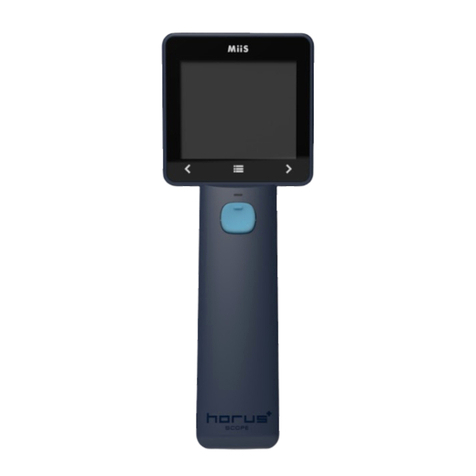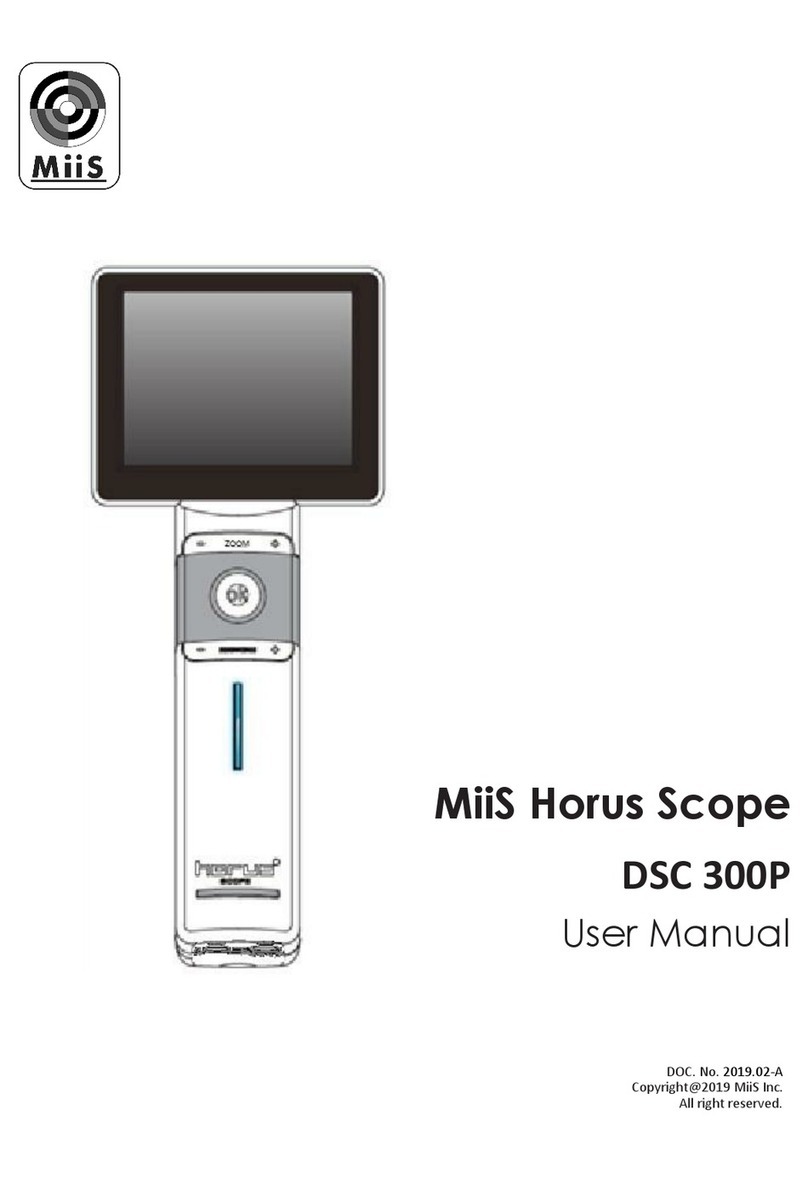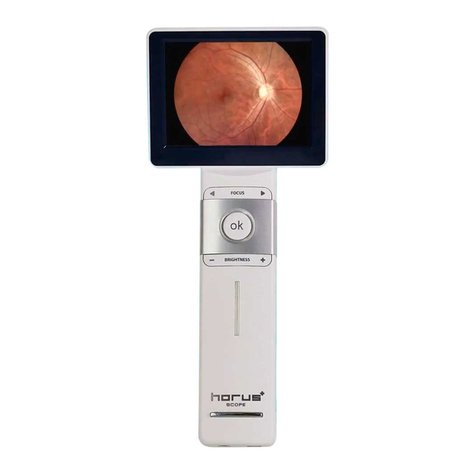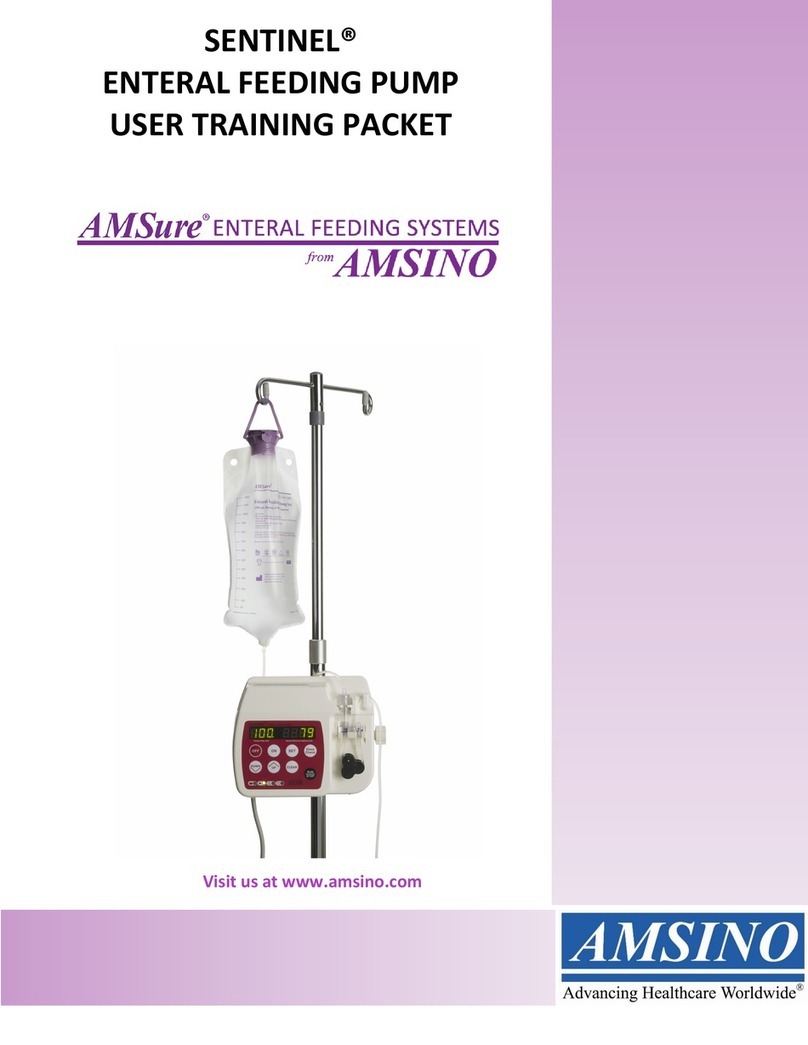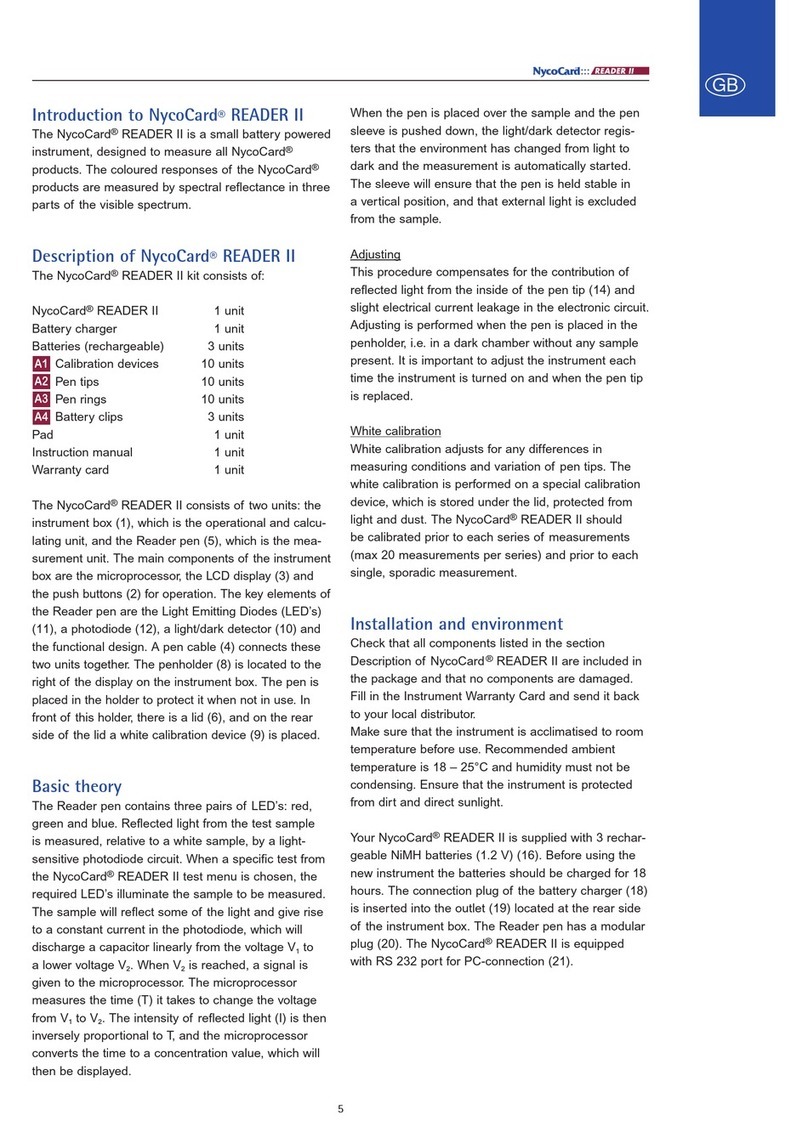MiiS Horus Scop DSC 300 User manual

MiiS Horus Scope
DSC 300
User Manual
DOC. No. 82.0022-000001-01
Ver. D
Date of issue: May, 2022
Copyright@2022 MiiS Inc.
All right reserved.

2

3
Contents
Preparations ........................................................................................ 4
•Before use .................................................................................. 4
•Indication for Use ....................................................................... 4
•Contraindications ....................................................................... 4
•Names of components ............................................................. 11
•Charging the battery................................................................. 16
•Power indicator ........................................................................ 17
•Assembling ............................................................................... 18
•Using the Setup mode.............................................................. 19
A. DEC 200.......................................................................... 19
B. DEA 200.......................................................................... 28
C. DGC 200 ......................................................................... 34
•Entering the patient ID ............................................................. 39
Taking pictures................................................................................... 42
•A. DEC 200................................................................................ 42
•B. DEA 200................................................................................ 46
•C. DGC 200................................................................................ 52
•Photo mode.............................................................................. 53
•Video mode.............................................................................. 54
Playback............................................................................................. 55
•Display mode............................................................................ 55
Chin Rest............................................................................................ 57
Miscellaneous.................................................................................... 58
•File transferring ........................................................................ 58
•Viewing on a computer/laptop screen..................................... 58
•Viewing on a TV screen ............................................................ 58
•UVC and HDMI.......................................................................... 58
•Technical description................................................................ 59
•Liability ..................................................................................... 60
•Disposition................................................................................ 60
•Symbols and standards............................................................. 61

4
Preparations
Before use
Prior to installation and start-up of the Horus Scope, carefully read the user manual. As with all
technical devices, the proper function and safety operation of this device depend on the user
complying with the safety recommendations described in these operating instructions. In
addition, please make sure that it does not appear damaged or broken. If there are breaks on
the outer casing or other visual defects, please contact the manufacturer or a certified service
facility.
Caution: Federal law restricts this device to sale by or on the order of a physician, and other
countries shall be follow.
Indication for Use
Intended for qualified healthcare professionals who are trained in its use.
The device is intended to be used in professional healthcare (e.g. hospital or clinic, etc.)
The device may be used on any human group.
The device does not provide a diagnosis or therapy.
The clinical benefit is for healthcare professionals, helping deliver state-of-the-art care to their
patients.
Contraindications
This instrument must not be used for the following patients:
•
Patients who are hypersensitive to light.
•
Patients who recently underwent photodynamic therapy (PDT).
•
Patients taking medication that causes photosensitivity.
•
Patients with a history of migraines.
•
Patients with a history of photosensitive epilepsy.
•
Patients with any kind of disease which could be induced by flash or strong light.
Camera handling
Protect the camera from excessive vibration, force, or pressure.
Avoid using the camera under the following conditions, which may damage the lens, the
monitor, or the control unit and may also cause the camera to malfunction or prevent
recording:
•
Dropping or hitting the camera against a hard surface.
•
Exerting excessive force on the lens or themonitor.
The camera is not dust resistant, splash resistant, or waterproof. Avoid using the camera in
places with excessive dust or sand, or where water can come into contact with the camera.
Avoid using the camera under the following conditions, which present the risk that sand,
water, or foreign material may enter the camera through the lens or gaps around buttons.
Be especially careful because these condition may damage the camera, and such damage
may not be repairable:
•
Operate in extremely dusty or sandy places
•
Exposing the camera to rain or moisture

5
Focus calibration
A. Focus calibration of DEC 200 (→ 44)
When using DEC 200 under the following conditions, focus calibration is necessary.
•
The last four digits of the serial number of the control unit and optical lens do not
match.
•
The control unit or optical lens is used for the first time after it is returned from repair.
B. Focus calibration of DEA 200(→ 47)
Condensation (when the lens or the monitor is fogged up)
Condensation may occur when the camera is exposed to sudden changes of temperature or
humidity. Avoid these conditions because they may soil the lens or the monitor, cause mold,
or damage the camera.
If condensation does occur, turn off the camera and wait for about two hours before using
it. Once the camera adjusts to the surrounding temperature, the fogging will clear naturally.
Safe eye screening
While no acute optical radiation hazards have been identified with the camera, it is
recommended that the intensity of light directed into the patient’s eye be limited to the
minimum level necessary for diagnosis. Infants, aphakes, and persons with diseased eyes are
at greater risk. The risk may also be increased if the person being examined has had any
exposure to the same instrument or any other ophthalmic instrumentthat uses a visible light
source within the previous 24 hours. This will apply particularly if the eye has been exposed
to retinal photography. The intended use of this device is for routine ophthalmic exams of
typically less than 60 seconds per eye. While any medical procedure has its benefit versus
risk factor, more complicated exams should not exceed three minutes of exam time within
24 hours. Significant use of this device beyond its intended use is not recommended as it
may cause harm to the eyes.
During the operation of using the camera, please follow the below instructions.
•
Always use the camera or accessories in accordance with the directions and
recommendations contained in this user manual.
•
When operating the device, please make sure that the optical lens does not touch the
eyes or nose of the patient in order to avoid harm.
•
For illumination and photography with the camera, do not select an exposure higher
than required. Do not shine light on the eye beyond the recommended time during
examination. Otherwise, the examined eye may experience pain or be injured.
No compensation for missedshots
We cannot compensate for missed shots if technical problems with the camera or card
prevent recording.
If focus calibration is not performed, the auto focus function may
fail to work properly.
To ensure the quality and performance of image, calibrate the working
distance of your DEA 200 every month is recommended.
Preparations

6
Usage cautions andnotes
When in use
The camera may become warm if used for long periods of time, but this is not its fault.
Keep the camera as far away as possible from electromagnetic equipment (such as
micro- wave ovens, TVs, video games, etc.).
Do not use the camera near radio transmitters or high-voltage lines.
Never leave the camera and the battery in a car or on a car hood in the summer. Doing
so may cause leakage of the battery electrolyte, overheating, fire, or a battery
explosion due to the high temperature.
If the fundus lens and control unit get wet, do not attempt to dry with a heater,
microwave, autoclave, or UV light.
Do not extend the supplied cables. Do not keep the power cord near any heat source.
When the camera is not in use, please disconnect the power plug and keep it in a safe
place.
The performance criteria of the following description are accepted when operating the
device: temporary function abnormal but can be resumed after restarting without
operator intervention. Unless basic safety cannot be achieved.
In any operating conditions, the camera can be returned to the photo mode is regarded
as the normal state.
Charging the batter
The time required for charging varies depending on the conditions of battery usage.
Charging takes longer at high or low temperatures and when the battery has not been
used for some time.
The battery will get warm during charging and for some time thereafter.
The battery will be drained completely if not used for long periods of me, even after
being charged.
Only use Li-ion Battery 3.6V/Capacity 3350mAh which shall be provided by the
manufacturer or distributors. The battery has designed the protection circuit. To
ensure the safety of the product operation, if the battery reaches its life time, please
contact the manufacturer or distributor to buy the spare battery.
NOTE
The battery cannot be affected by external force impact. Its appearance cannot be
damaged. If the battery is broken or damaged by external force, DO NOT USE to avoid
dangerous.
Optical Radiation hazard
“CAUTION – The light emitted from this instrument is potentially hazardous. The longer
the duration of exposure, the greater the risk of ocular damage. Exposure to light from
this instrument when operated at maximum intensity will exceed the safety guideline
after 60 seconds.”

7
RELATIVE SPECTRAL DISTRIBUTION OF ILLUMINATION LIGHT
Memory cards
If you purchase different memory capacity of memory card, must be preceded format
to FAT32.
To prevent damage to cards and data:
•
Avoid high temperatures, direct sunlight, electromagnetic fields, and static
electricity.
•
Do not bend, drop, or expose to strong impacts.
•
Do not touch the terminals or allow them to become dirty or wet.
•
When operating this device, please do not remove or insert the memory card.
When disposing of/transferring memory cards:
If using the “format” or “delete” functions on your camera or computer, this only
changes the file management information and does not completely delete the data
from the memory card. When disposing of or transferring your memory cards, we
recommend physically destroying them or using commercially available computer data
erasing so ware to completely delete the data from the card. Data on memory cards
should be managed responsibly.
Accessories
About the Fundus Image Management System (L type), Model: SD 1:
The Fundus Image Management System is a software which can analyze optic nerve
images shot by DEC 200.
It can estimate the relative amount of hemoglobin at different regions of the optic
nerve, and other indexes such as Vertical Cup/Disc ratio, the Cup/Disc area ratio.
Please refer to the user manual of SD 1 for more details.

8
About the slit lamp jig:
Attach the slit lamp jig only to slit lamp equipment that has been qualified by MiiS.
Make sure the jig is completely locked by pushing it downward.
The slit lamp jig is only suitable for DEC 200.
Protection
Do not attempt to remove the cover from the product to prevent the product from
malfunctioning.
No modification of this device is allowed. The performance would be subject to any
modification and may cause hazardous radiation exposure.
EMC (electromagnetic compatibility)
During installation and opera on of the device, observe the following instructions:
Do not use the device simultaneously with other electronic equipment to avoid
electromagnetic interference with the operation of the device.
Do not use or stack the device near, on, or under other electronic equipment to avoid
electromagnetic interference with the opera on of the device.
Do not use the device in the same room as other electronic equipment, such as life-
support equipment that has major effects on the life of the patient and results of
treatment, or any other measurement or treatment equipment that involves small
electric current.
Do not use the system with portable and mobile radio frequency communication
systems because that may have an adverse effect on the operation of the device.
Do not use cables or accessories that are not specified for the device because that may
increase the emission of electromagnetic waves from the device and decrease the
immunity of the device to electromagnetic disturbance.
Do not touch the lens connecting pins of the control unit or the signal pad of the lenses
without special precautions.
When operating the device simultaneously with other electronic equipment, please
make sure the distance between two devices is no closer than 30 cm (12 inches),
including cables specified by the manufacturer.
Cleaning and Disinfection
The device is a precision photo electronic instrument that shall be handled with specific
care. Please note the following cleaning instructions:
Turn off the device before cleaning it.
Disinfect the control unit and charging station with CaviWipes and maintain 3~5mins.
Wait for the cleaning liquid to dissolve before turning the power on and connecting the
charging station and USB cable to the control unit.
It is recommended to clean the fundus lens with a CaviWipes that is commercial product
and be manufactured by THORLABS Inc. (www.thorlabs.com).
If a replacement for the eyecup or rubber pad is needed, please contact the
manufacturer or retailer.
Clean the eyecup or rubber pad before each use.

9
Disinfect the eyecup or rubber pad with CaviWipes.
NOTE
The device is not intended to be sterilized. Disinfect the control unit and charging
station with CaviWipes).
Maintenance
Please check control unit and optical lens once every 3 months.
OperatingEnvironment
•Ambient temperature: 10°C to +35°C
•Relative humidity: 30% to 90%
•Atmospheric pressure: 800hPa to 1013hPa
•Shock (without packing): 10G, duration 6ms
Environment for Storage
•Ambient temperature: -10°C to +55°C
•Relative humidity range: 10% to 95%
•Atmospheric pressure: 700hPa to 1013hPa
NOTE
It is recommended to remove the battery if the device is stored over two weeks.
Environment for Transportation
•Ambient temperature: -40°C to +70°C
•Relative humidity range: 10% to 95%
•Atmospheric pressure: 500hPa to 1013hPa
•Vibration, sinusoidal: 10Hz to 500Hz: 0.5G
•Shock: 30G, duration 6ms
•Bump: 10G, duration 6ms
NOTE
It is recommended to remove the battery if the device is stored over two weeks.
Regulations
Any serious incident that has occurred in relation to the device should be reported to
It is the health care provider to protect patient health information and to meet
regulatory and HIPAA compliance. The images on DSC 300 may contain
identifiable patient information and it is the responsibility of the health care
provider to ensure that data safeguards are implemented to protect patient
health information.
Please note that the actual controls and components, menu items, and other
information of your camera may differ from those in the illustrations provided in
these instructions.

10
the manufacturer and the competent authority of the Member State in which the user
and/or patient is established.
This device has been tested and found to comply with the limits for medical devices to
the IEC 60601-1-2: 2014. These limits are designed to provide reasonable protection
against harmful interference in a standard medical installation. If this device does cause
harmful interference to other devices, which can be determined by turning the system
off and on, the user is encouraged to try to correct the interference through one or more
of the following measures: Reorient or relocate the receiving device.
•Increase the separation between the system and other devices.
•Connect the device to an outlet on a circuit different from that to which the
other device(s) are connected.
•Consult the manufacturer or field service technician for help.
The International Electrotechnical Commission sets the essential requirements for
electrical and electronic equipment that may disturb or be disturbed by other
equipment. The device complies with these requirements as shown in the tables in
“Symbols and standards: EMC” (→ 64). Follow the guidance in the tables for use of the
device in an electromagnetic environment.
IT Network Security
Computers used to connect to the device should be note the following security
instructions:
Make sure anti-virus software is installed in personnel computer before connecting the
device to it and keep the latest version.
Recommended anti-virus software,
• ESET Endpoint Antivirus
• Bitdefender Antivirus
• kaspersky anti-virus
The device can only be updated or processed by original factory or a legally authorized
distributor. Do not allow unauthorized persons or users to update or process the
software with any memory card.
Users must keep patient information in a safe place.
Physically destroyed the memory card when abandoned.

11
Names of components
Scope of Delivery
Product Name
Model Name
Accessories
Control unit
MiiS Horus Scope
DSC 300
1. Battery
2. Power adapter
3. Mini USB cable 1.8m (Shield)
4. Micro HDMI cable 2.0m (Shield)
5. Charging station
6. Memory card
7. Portable chin rest (Optional)
8. Image Management System,
Model: SA 1 standalone (option)
9. Image Management System,
Model: SB 1 (free download)
10. Image Management System,
Model: SD 1 standalone (option)
Eye Fundus
Camera
MiiS Horus+Scope
DEC 200
1. Eyecup
2. MiiS Horus Portable Chin Rest: CR
100 (Optional)
3. Slit lamp jig (Optional)
Eye Anterior
Camera
MiiS Horus+Scope
DEA 200
1. Forehead
Eye Surface
Camera
MiiS Horus+Scope
DGC 200
Intended for use
MiiS Horus+ Scope DEC 200 is a digital hand-held eye fundus camera used to record digital
photographs and video of fundus (including retina, macula, and optic disc) of the human eye
and surrounding area.
MiiS Horus+Scope DEA 200 is a digital hand-held eye anterior camera used to record digital
photographs and video of anterior segment (including cornea, anterior chamber, and lens) of
the human eye and surrounding area
MiiS Horus+ Scope DGC 200 is the eye surface optical lens used to record digital photographs
and video of anterior area of human eye and surrounding area.
It is the health care provider to protect patient health information and to
meet regulatory and HIPAA compliance. The images on DSC 300 may
contain identifiable patient information and it is the responsibility of the
health care provider to ensure that data safeguards are implemented to
protect patient health information.

12
User interface
Control Unit (MiiS Horus Scope DSC 300)
Top view ››
Front view ››
Power button
Lens lock
Power indicator
Brightness decrease/increase in
photo mode
OK button:
•
Completely press down to take a
photo
•
Back to photo/video mode while
previewing photos
Manual focus
3.5” LCD touch panel

13
Bottom view ››
Rear view ››
Mini USB
Pogo pad
Micro HDMI
Strap hook
Lens assembling mark
Cover glass and sensor
Lens connecting pins
Battery cover
Memory card slot
Repair hole

14
Charging Station
Mini USB connector

15
Optical Lens of MiiS Horus+Scope DEC 200 (Eye Fundus Camera)
Optical Lens of MiiS Horus+Scope DEA 200 (Eye Anterior Camera)
Optical Lens of MiiS Horus+Scope DGC 200 (Eye Surface Camera)

16
Charging the battery
Always charge before first use
Prior to first use, insert the battery into the control unit and closethe battery cover referred
to the below section. Connect USB connector to the power adapter. Let the battery be
charged for at least fivehours.
Battery replacement
Open the battery cover by digging out the gap in the bottom of battery cover with a
finger or something pointed.
•
Tilt the battery cover and remove the battery cover by lifting it up.
•
Remove the original battery and replace a new battery along the correct direction.
•
Place the battery cover and secure it inplace.
Connect to a
power adapter
Extra usb powered,
connect to second
usb port on NB

17
Power indicator
Power indicator
System Status
Power off
Power on
Light color
No Light
Blinking blue
Light
Orange Light
Blue Light
Blinking blue
Light
Mixed blue
and
orange Light
Information
System off
Power less
than 25%
Charging
Normal
operation
Power less
than 25%
Connect to PC
via USB cable
or enable USB
live video

18
Assembling
(Take Eye Fundus Camera as an example.)
Step 1. ↘
Align the marks of the optical lens and control unit.
Mark
FOCUS
Mark on the
optical lens
Step 2. →
Hold the optical lens and attach it to the
control unit. Rotate and fasten the optical lens
in a clockwise direction. You will hear a click
when the lens locks into the controlunit.
Step 4. →
To unlock the optical lens, press
the lens lock and then rotate the
optical lens in a counterclockwise
direction. Then the optical lens
will be unfastened.
Step 3. ←
Turn on the power (→12). When optical lens and control unit
are assembled correctly, the information icons will appear on
the top of LCD touch panel. The screen will turn on, and then
the blue light of the power indicator (→ 17) will also turn on.

19
Using the Setup mode
Turn on the power
To turn on the system, press the power button (→ 12) to turn on the control unit.
Approximately one to two seconds later, the boot screen will appear on the LCD panel.
Note:
When below conditions occur, user needs to turn off the power and reassemble the optical
lens and control unit.
1. Optical lens isn’t correctly assembled to the control unit.
When turning on the device, the device stays at boot screen and can’t enter to
control interface.
2. The black screen appears on the LCD panel during operation.
Please check the optical lens is well-assembled to the control unit.
A. DEC 200
Enter the Setup mode
Using the [Setup] menu
It is recommended that all setting items are set according to user’s requirements for first-
time use.
Bring up the [Setup] menu
Touch the photo icon and then touch the setup icon.
Exit the [Setup] menu
Once a setting adjustment is made, the new value affects the system immediately. Use the
upper back button or the OK button to exit the screen.

20
Settings
[Aiming Light/Capture Light]
The default setting of [Aiming Light/Capture Light] is [IR/White LED]. In the setting, DEC
200 employs IR illumination for alignment and focusing to assure patient comfort. With IR,
the user observes fundus images monochromatically. At the moment of pressing the
shutter button, the system will turn on the white LED instantly. Static images and motion
pictures will be captured in full color.
If the setting is [White LED/White LED], then the user observes images in full color and
capture static images and motion pictures in full color.
[IR brightness]
The IR brightness has 5 levels; the default setting is level 3. The range is from 1 to 5.
[WHT brightness]
The WHT brightness has 16 levels; the default setting is level 10. The range is from 0 to 15.
Table of contents
Other MiiS Medical Equipment manuals
Popular Medical Equipment manuals by other brands
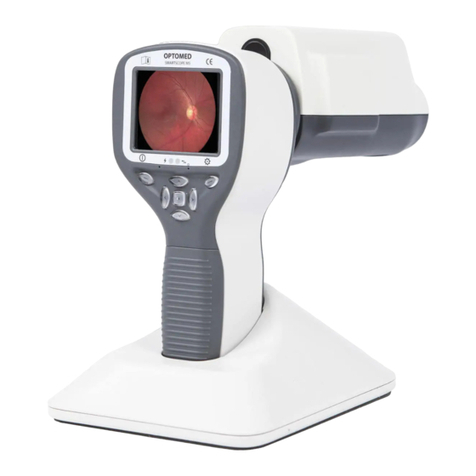
Optomed
Optomed SMARTSCOPE PRO - Simply Brilliant Troubleshooting

Ossur
Ossur Exoform Carpal Tunnel Wrist Instructions for use
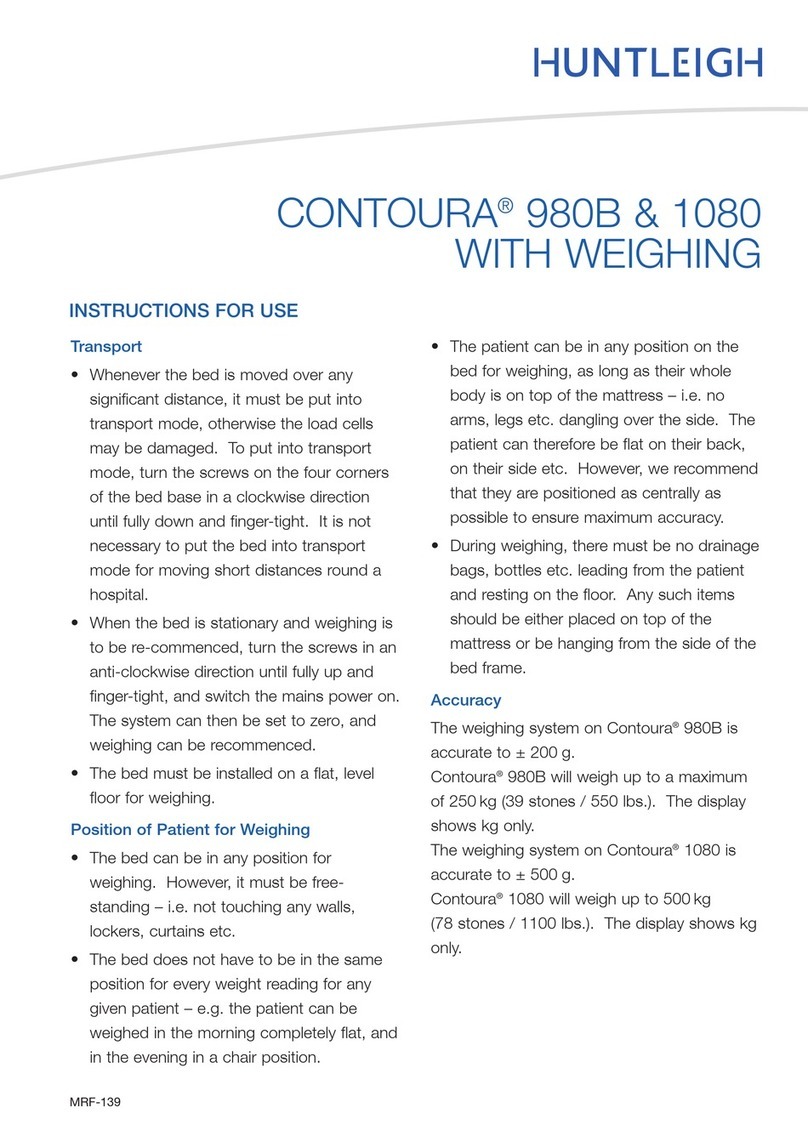
Huntleigh
Huntleigh CONTOURA 980B Instructions for use
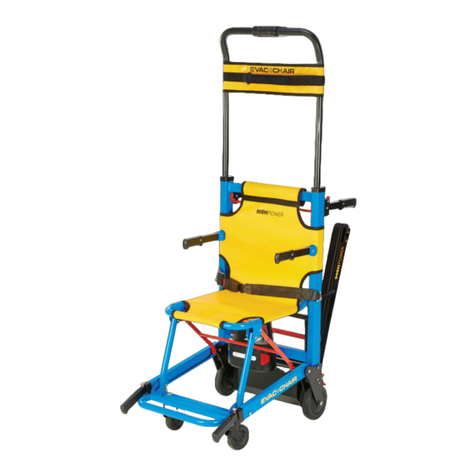
Evac+Chair
Evac+Chair 900H POWER user guide
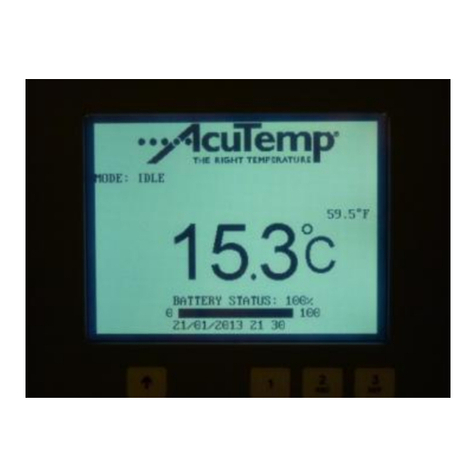
AcuTemp
AcuTemp CSafe RKN Series Easy Setup instructions

ResMed
ResMed AutoSet CS-A Welcome guide
